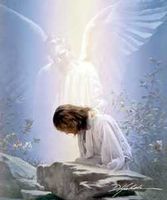15.3.2008 | 10:45
paramahansa
"In titling this work The Second Coming of Christ, I am not referring to a literal return of Jesus to earth....A thousand Christs sent to earth would not redeem its people unless they themselves become Christlike by purifying and expanding their individual consciousness to receive therein the second coming of the Christ Consciousness, as was manifested in Jesus....Contact with this Consciousness, experienced in the ever new joy of meditation, will be the real second coming of Christ — and it will take place right in the devotee's own consciousness."
—Paramahansa yogananda
 THE SECOND COMING OF CHRIST
THE SECOND COMING OF CHRISTThe Resurrection of the Christ Within You
A revelatory commentary on the original teachings of Jesus
Paramahansa Yogananda
One of the most eagerly awaited books in the history of Self-Realization Fellowship is Paramahansa Yogananda's revelatory interpretation of the teachings of Jesus Christ.In this unprecedented masterwork of inspiration, Paramahansa Yogananda takes the reader on a profoundly enriching journey through the four Gospels, verse by verse, and illumines the universal path to oneness with God taught by Jesus to his immediate disciples but obscured through centuries of misinterpretation: "how to become like Christ, how to resurrect the Eternal Christ within one's Self."
Never before available in its entirety, this landmark work by one of the most revered spiritual teachers of our time transcends divisive sectarianism to reveal a unifying harmony underlying all true religions. A groundbreaking synthesis of East and West, it imparts the life-transforming realization that each of us can experience for ourselves the promised Second Coming — awakening of the all-fulfilling Divine Consciousness latent within our souls.
The text is accompanied by more than 30 full-color and sepia reproductions of paintings and rare drawings of the life of Jesus, as well as a comprehensive glossary, index, and subject annotations.
Topics discussed in depth include:
| Product details:
|
What the Press is Saying About
The Second Coming of Christ
"Praised as a groundbreaking work..."
"[Yogananda's commentary] is being praised as the first detailed interpretation of the four Gospels by a Hindu. The Second Coming of Christ: The Resurrection of the Christ Within You offers startling ideas about the deeper meaning of Jesus' teachings and their essential unity with yoga, one of the world's oldest and most systematic religious paths to achieving oneness with God....It has been praised as a groundbreaking work by comparative religion scholars." (Read full review.)
— Los Angeles Times
"A masterpiece of spiritual revelation..."
"As Yogananda delves into the life and background of Jesus, it becomes clear that the Gospels contain a universal esoteric message that has been awaiting full and systematic explication since the apostolic age. In Yogananda's commentary, what had been veiled, obscure, and oblique is fully disclosed....A masterpiece of spiritual revelation." (Read full review.)
— Yoga International
"A majestic portrait of universality and depth..."
"A masterful work. The publication of The Second Coming of Christ, by Paramahansa Yogananda, has all the hallmarks of an epochal offering....Yogananda offers clarifications of a host of misunderstandings that have caused dissonance in Christianity and the way it is seen by people of other faiths....Yogananda penetrates this misinterpretation by explaining the distinctions between Jesus (the "son of man') and Christ, the honorific title acknowledging his exalted consciousness ( "son of God'); by providing the esoteric context of statements such as "I am the way,' and "No man cometh to the Father but by me;' by distinguishing between references to "sons of God' and the Trinitarian "only begotten son;' and by clarifying terms such as "everlasting fire,' "hell' and "judgment day.' The result is a majestic portrait of universality and depth. This is no ordinary work."
— Dayton Daily News
"Support for the ultimate convergence of science and religion..."
"Yogananda strips away the divisiveness and dogmatic approach that have accumulated around Jesus' teachings and affirms that it is possible for every individual — regardless of one's faith tradition — to have the same relationship that Jesus had with the Divine....One of the features that distinguishes Yogananda's commentary from most other Bible interpretations is his conviction that there is no inherent conflict between science and faith. His very accessible overview of the cosmology of India's seers, cited side-by-side with that of Einstein and the latest in theoretical physics, provides substantial support for the ultimate convergence of science and religion."
— Sacred Pathways
"Synchronizes with the need of the hour..."
"In a world that is full of hatred, violence, anger and darkness, the bringing out of The Second Coming of Christ: The Resurrection of the Christ Within You by Paramahansa Yogananda synchronizes with the need of the hour....The two-volume treatise provides a masterly interpretation of the teachings of Jesus Christ. True to the subtitle, the book is a revelatory commentary on the original teachings of Jesus."
— India Post
"Remarkable..."
"A remarkable new two-volume work...The Second Coming of Christ: The Resurrection of the Christ Within You contains insights that can help Christians see their faith in fresh ways."
— Kansas City Star
"Profoundly thought-provoking..."
"If you find it difficult to explain to devoutly Christian friends and relatives just what the philosophy of yoga is all about — especially why it is not in any way detrimental to your salvation or antithetical to the teachings of Jesus — then this massive two-volume work by the author of Autobiography of a Yogi may be for you....[It] casts a whole new light on Jesus' declaration, "I am the Truth, the Way, and the Life.' Yogananda's discourses make that Truth, that Way, and that Life seem attainable by anyone who pursues his or her sadhana (spiritual practice) diligently....Profoundly thought-provoking rumination on the ultimate meaning of perhaps the most studied — and, arguably, misunderstood — incarnation in human history. More than half a century after his mahasamadhi (passing), Yogananda is still illuminating the yogic path."
— Yoga Journal
"Rich with spiritual principle and inspiration..."
"If you're up for a spiritual journey that will explain verses you've heard all your life, but never fully comprehended, this is the book for you. Or, if you're interested in expanding your wisdom and spiritual consciousness, this is the book for you. This book is beautifully written, with great reverence and divine love; you get a glimpse of what it is to be in the company of a great and divine personage, such as Jesus. I highly recommend the book."
— 21st Century Books.com
"A unique perspective..."
"The Second Coming of Christ adds a distinctively unique perspective on the New Testament from a spiritual leader who saw Jesus Christ as a unifying figure...not a divisive one."
— Earth Star
"Breathes with the same heartfelt wisdom and gentle beauty that we associate with Autobiography of a Yogi..."
"Takes the reader on a powerfully enriching journey....This revelatory commentary on the original teachings of Jesus is copiously illustrated, and Yogananda's text breathes with the same heartfelt wisdom and gentle beauty that we associate with the Autobiography of a Yogi. If for any reason you may have lost touch with Jesus' message, Yogananda is an ideal companion to reawaken you to its meaning and majesty."
— Adyar Booknews (Australia)
"Incisive light on the teachings of Jesus.... Magnificent."
"Paramahansa Yogananda was a spiritual master who contributed significantly to introducing yoga to America. Now, after his passing, a new text has come forth, creating a graceful bridge between yoga and Christianity, shining incisive light on the teachings of Jesus....If you have been touched by yoga or the New Testament, this will be a magnificent gift for yourself or a loved one."
— Alan Cohen's Newsletter, Insights for Richer Living
"A must-read..."
"Fascinating.... A must-read for anyone exploring their spiritual side and interested in different aspects of faith."
— Nature and Health (Australia)
Lífstíll | Breytt s.d. kl. 19:48 | Slóð | Facebook | Athugasemdir (3)
4.3.2008 | 20:19
svo fallegt vona að hann vinni idolið
Lífstíll | Breytt s.d. kl. 20:56 | Slóð | Facebook | Athugasemdir (5)
'A hvaða veg getur lífsspeki krishnavitundar haft á hvernig fólk lifir ?
Hún linar þjáningar fólks.Fólk þjáist vegna þess að það stendur í þeirri röngu trú að það sjálft sé líkaminn.Haldið þér að yður liði vel ef þér hélduð að þér væruð skyrtan yðar og jakkinn,þvæuð hvort tveggja vel og vandlega en gleymduð að þvo líkamann og neyta matar.
Lífstíll | Breytt 4.3.2008 kl. 10:16 | Slóð | Facebook | Athugasemdir (3)
15.2.2008 | 22:43
prayer
What do you say while you are praying? To whom are you speaking? Have you ever prayed for others, for the world, for peace? How have you done this? How to pray? With tears in our hearts. Where to pray? In a lonely place. When to pray? The moment our inner being wants us to pray. Why to pray? This is the question of questions. We have to pray if we want our aspirations to be fulfilled by God. |
|
Lífstíll | Slóð | Facebook | Athugasemdir (5)
15.2.2008 | 20:30
The mind
Lífstíll | Slóð | Facebook | Athugasemdir (2)
3.2.2008 | 18:37
er að spá í að lita á mér hárið dökkt



 en já málið er að þora hvað segið þið sem lesið þetta haldiði að það fari mér að lita það dökkt ? eða rauðbrúnt ? eðaá ég bara að halda mig við ljóst
en já málið er að þora hvað segið þið sem lesið þetta haldiði að það fari mér að lita það dökkt ? eða rauðbrúnt ? eðaá ég bara að halda mig við ljóst 3.2.2008 | 00:01
grænir sjeikar
Aldrei að segja aldrei…..
Það geta allir og allt breyst. Það á aldrei að segja aldrei…… Ég á vin sem alla tíð hefur verið sá mesti anti sportisti, anti grænmetis og heilsumanneskja sem ég held að gangi á jarðarkringlunni. Það skiptir ekki máli hvað sagt er, ef það tengist hollustu í einhverri mynd þá kemur þvílíki fyrirlesturinn um hvað bla bla bla bla þetta sé nú allt öfgakennt og afi hans hafi nú lifað á tólgum og uppstúf og orðið 100 ára. Ég samgleðst bæði honum og afa hans og bendi honum á að það væri nú aldeilis mikið sem sparaðist í heilbrigðiskerfinu ef allir væru nú eins og hann afi hans, og nóta bene ef ég ætti að tilnefna 1 manneskju sem ætti að klóna þá myndi ég tilnefna gamla manninn.
Þessi vinur minn flutti erlendis fyrir nokkrum árum og ég rakst á hann núna um daginn. Hann var með nýrri kærustu, sérstaklega glæsilegri konu. “Hæ Solla, mig langar til að kynna þig fyrir konunni minni. Hún er í svipuðum geira og þú, heldur námskeið í jóga og reiki.” Ég kynnti mig og við tókum tal saman. Og þrátt fyrir að ég sé hvorki að kenna jóga eða reiki þá náðum við að spjalla fullt. “Ég er búin að heyra svo mikið um þig” sagði konan og brosti, “Ég var farin að hlakka til að hitta þig”.
Síðan opnaði vinur minn sig og sagði að hann væri allur annar eftir að hún hefði komið honum upp á grænu sjeikana. Ég þurfti að hafa mig alla við að springa ekki úr hlátri. Og ég næstum því gleypti tunguna mina þegar hann sagði mér stolltur að hann væri að læra kristalla heilun á helgarnámskeiðum. Svona getur nú ástin aldeilis galdrað í lífi fólks.
Hann hefði meira að segja tekið yfirmann sinn (bankastjóra í íslenskum banka erlendis) í smá meðferð og væri sá eins og nýslegin túskildingur.
Grænir sjeikar
Grænir djúsar og grænir hristingar innihalda mikið af góðum trefjum.
Uppleysanlegu trefjarnar í djúsnum, binda kólestról í þörmunum og losa líkamann við það, hjálpa og örva hægðir og stabilísera blóðsykurinn.
Það sem grænu hristingarnir hafa fram yfir djúsana er að þeir innihalda bæði uppleysanlegar og óuppleysanlegar trefjar. Óuppleysanlegu trefjunum má líkja við svamp, þær geta dregið í sig margfalda stærð sína af eiturefnum sem þær taka með sér útúr líkamanum. Með grænum hristingum getum við innbyrt mjög mikið magn af græna litnum ásamt öðru grænmeti og ávöxtum.
Með því að nota blandarann erum við að brjóta hráefnið niður til þess að auðvelda meltinguna (formelta) og gefa líkamanum greiðari aðgang að næringunni. Ef við erum dugleg að auka græna litinn í fæðunni gerir það okkur kleift að þola betur þann mat sem við erum að borða dags daglega hver svo sem hann er.
Ég hef hérna fullt af glænýjum uppskriftum af grænum sjeikum og hvet ykkur til að prófa ykkur áfram og finna út hvað hentar ykkar kroppi.
Gangi ykkur sem allra best
Solla
Grænn súkkulaði sjeik
2 dl kókosvatn eða vatn
100g spínat*
5 döðlur*
2 bananar
1 msk kakóduft*
½ tsk alkaliveduft
nokkrir klakar
Byrjið á að setja kókosvatnið eða vatnið í blandarann ásamt spínatinu og döðlunum og blandið vel saman. Setjið restina af uppskriftinni útí og blandið þar til þetta er orðið silkimjúkt.
Græna gúrkan
2 dl kókosvatn eða vatn eða nýpressaður eplasafi
100g spínat
½ agúrka
½ lime
½ avocado
¼ búnt ferskur kóríander eða annað grænt krydd ef vill
Skerið agúrkuna í sneiðar, afhýðið límónuna og avókadóið og skerið í bita. Allt nema avókadóið er svo sett í blandara og blandað þar til silkimjúkt. Bætið avókadóinu útí og blandið vel.
Græna steinseljan
2 dl kókosvatn
1 búnt steinselja
100g romain salat, skorið í bita
100g græn vínber
slatti fersk myntulauf
½ tsk alkalive duft ef vill
nokkrir ísmolar
Setjið kókosvatnið/vatnið í blandara ásamt steinselju og blandið smá stund. Bætið restinni af uppskriftinni útí og blandið þar til allt er vel blandað saman og kekklaust.
Grænn og ferskur ávaxta og berjasjeik
2 ½ dl ananassafi eða kókosvatn
safinn úr ½ limónu
2 dl ferskir eða frosnir mangóbitar
2 dl frosin ber, t.d. bláber, hindber eða jarðaber
50 g spínat
½ - 1 avókadó, afhýtt og skorið í bita
Setjið vökvann í blandarann ásamt mangó bitum og blandið vel. Bætið frosnum berjum útí og blandið, bætið síðan spínati og avókadó útí og blandið þar til allt er orðið silkimjúkt.
Græna próteinbomban – kaaabúmmmm
2-3 dl möndlumjólk eða sojamjólk
75g tófú
2 dl jarðaber, skorin í bita
1 - 2 bananar, afhýddir og skornir í bita
½ avókadó, afhýtt og skorið í bita
50 g spínat
50g alfalfaspírur ef vill
1 msk hvítt tahini
½ tsk alkaliveduft
nokkrir klakar
Setjið möndlu/sojamjólkina í blandara ásamt jarðaberjum + tófú og blandið vel saman. Bætið restinni af uppskriftinni útí og látið þetta blandast vel. Þessi er sérstaklega góður eftir ræktina eða bara sem hin fullkomna máltíð.
Græna limónan eða sítrónan
2 dl kókosvatn eða vatn
safi og hýði af 1 sítrónu eða limónu
1 lífrænt og grænt epli, skorið í fernt og steinhreinsað
100g spínat
¼ búnt fersk mynta (bara laufin – ekki stöngullinn)
½ - 1 avókadó
Setjið kókosvatnið í blandara ásamt sítrónusafa + hýði og epli og blandið vel. Bætið restinni af uppskriftinni útí og blandið þar til allt er orðið silkimjúkt.
Grænn og kryddaður
2 ½ dl kókosvatn eða vatn
2 græn og lífræn epli, skorin í fernt og steinhreinsuð
2 msk ferskt dill
2 tsk ferskt rósmarin, smátt saxað
nokkrir klakar
Allt sett í blandara og blandað vel saman.
Molar
Vissir þú
að ananas innihaldur ákveðin ensým sem gera hann að náttúrulegu verkjalyfi? Þetta sýna rannsóknir frá Reading University
að ferskur kóríander (cilantro) er sagður virkur við að lækka kólesterólið í kroppnum?
Að avókadó inniheldur seratónin? Við Íslendingar ættum því að kannski að borða meira af því í skammdeginu….
solla
Lífstíll | Breytt s.d. kl. 00:24 | Slóð | Facebook | Athugasemdir (1)
26.1.2008 | 02:22
Mega bleikt draumahús


 passa húsin ekki vel við mig :) ekkert lítið hallærisleg mynd af mér hihi tók hana ekki sjálf tek það fram .ég hélt voða mikið upp á þessa húfu sem ég gerði fyrir einu ári siðan af því þetta var fyrsta húfan sem ég hef prjónað .'Anægð með að geta loksins klárað eitthvað á minni ævi sem var húfa
passa húsin ekki vel við mig :) ekkert lítið hallærisleg mynd af mér hihi tók hana ekki sjálf tek það fram .ég hélt voða mikið upp á þessa húfu sem ég gerði fyrir einu ári siðan af því þetta var fyrsta húfan sem ég hef prjónað .'Anægð með að geta loksins klárað eitthvað á minni ævi sem var húfa  en í leiðinni lýsir vel bleiku geðveikinni sem ég er búin að koma mér í .Aldrey þoldi ég bleikan lit ég sá allt rautt þegar einhverjum datt í hug að klæðast bleiku.En einn daginn gerðist eithvað eftir margra ára hatur mér fór að líka við bleikt
en í leiðinni lýsir vel bleiku geðveikinni sem ég er búin að koma mér í .Aldrey þoldi ég bleikan lit ég sá allt rautt þegar einhverjum datt í hug að klæðast bleiku.En einn daginn gerðist eithvað eftir margra ára hatur mér fór að líka við bleikt veit ekki afhverju og skil það ekki heldur.Þannig núna er ég með bleikt sturtuhengi ,bleik handklæði,bleika mottu,og inni í svefnherbergi bleik gluggatjöld ,og núna langar mér að mála svefnherbergið ljósbleikt og mig langar að eignast bleikt hús eins og er á myndunum hér fyrir ofan ,hvað er að gerast
veit ekki afhverju og skil það ekki heldur.Þannig núna er ég með bleikt sturtuhengi ,bleik handklæði,bleika mottu,og inni í svefnherbergi bleik gluggatjöld ,og núna langar mér að mála svefnherbergið ljósbleikt og mig langar að eignast bleikt hús eins og er á myndunum hér fyrir ofan ,hvað er að gerast  ég bara spyr þetta er ekkert lítið grunsamlegt sko og svo já líka þá langar mig í svona hans og grétu sumarbústað ég væri allavega voða vinsæl þá hjá yngri kynslóðinni :)
ég bara spyr þetta er ekkert lítið grunsamlegt sko og svo já líka þá langar mig í svona hans og grétu sumarbústað ég væri allavega voða vinsæl þá hjá yngri kynslóðinni :)

 ohhhh
ohhhh þetta hús mun einhver gefa mér í afmælisgjöf einn daginn, i wish
þetta hús mun einhver gefa mér í afmælisgjöf einn daginn, i wish 


 og svo ef ég verð ekki efnaðari en ég er í dag þá gæti ég kannski eignast þetta hús það væri alveg nóg líka
og svo ef ég verð ekki efnaðari en ég er í dag þá gæti ég kannski eignast þetta hús það væri alveg nóg líka allavega bleikt :)og svo væri sniðugt að fá sér bleikt hjól í stíl svona til að toppa þetta
allavega bleikt :)og svo væri sniðugt að fá sér bleikt hjól í stíl svona til að toppa þetta  gæti átt nokkur til tilbreytingar
gæti átt nokkur til tilbreytingar ég þarf ekkert að efast um það að verða kölluð Inga klikk ef draumurinn verður að veruleika ætli einhver myndi vilja giftast mér
ég þarf ekkert að efast um það að verða kölluð Inga klikk ef draumurinn verður að veruleika ætli einhver myndi vilja giftast mér
Lífstíll | Breytt s.d. kl. 02:36 | Slóð | Facebook | Athugasemdir (8)
24.1.2008 | 03:39
hinduismi
Who is the founder of Hinduism?Hinduism has no founder, it developed out of Brahminism. Hinduism is the oldest religion, it may date to prehistoric times. |
|
Where does the name Hindu come from?The word "Hindu" comes from the name of the river Indus, which flows 1800 miles from Tibet through Kashmir and Pakistan to the sea. |
How is Hinduism different from other faiths?Hinduism has no founder, single teacher nor any prophets. |
What do Hindus believe?For many Hindus, religion is a matter of practice rather than of beliefs. It's more what you do, than what you believe. Hindus believe in a universal soul or God called Brahman. Brahman takes on many forms that some Hindus worship as gods or goddesses in their own right. Hindus believe that there is a part of Brahman in everyone and this is called the Atman. Hindus believe in reincarnation - a belief that the soul is eternal and lives many lifetimes, in one body after another. The soul is sometimes born in a human body, sometimes in an animal body and sometimes in a plant body etc.. Hindus believe that all forms of life contain a soul, and all souls have the chance to experience life in different forms. Samsara means going through the cycle of repeated births and deaths (reincarnation). Hindus believe that existence of this cycle is governed by Karma. |
What is Karma?Hindus believe that the soul passes through a cycle of successive lives and its next incarnation is always dependent on how the previous life was lived. (Similar to Buddhist beliefs) Karma is the cause of our particular destiny. Misfortunes in our present life are the result of acts that we have committed in the past. In the same way, our actions in our present lives will determine our fate in the lives that follow. Hindus therefore aim to live in a way that will cause each of their lives to be better than the life before. |
What is Moksha?The spiritual goal of a Hindu is to become one with Brahma. This freedom is referred to as moksha. Until moksha is achieved, a Hindu believes that he/she will be repeatedly reincarnated in order that he/she may work towards self-realization of the truth (the truth being that only Brahman exists, nothing else). |
How do Hindus achieve Moksha?There are four different paths to achieve Moksha which a Hindu can take. The Hindu can choose one or all four of the paths they are: 1 The path of knowledge - Jnana-Yoga Spiritual knowledge -leading to the knowledge of the relationship between the soul (atman) and God (Brahman) 2 The path of meditation - Dhyana-yoga The idea is to concentrate so you can reach the real self within you and become one with Brahman 3 The Path of Devotion - Bhakti-yoga Choosing a particular god or goddess and worshipping them throughout your life in actions, words and deeds. 4 The path of good works - Karma-yoga This involves doing all your duties correctly throughout your life. |
Why are there so many Hindu Gods?Hindus actually only believe in one God, Brahman, the eternal origin who is the cause and foundation of all existence. The gods of the Hindu faith represent different forms of Brahman. These gods are sent to help people find the universal God (Brahman). Most Hindus have a personal god or godess such as Shiva, Krishna or Lakshmi to whom they pray regularly. The three most important Hindu gods are:
Other Hindu gods include: Saraswathi - Goddess of Wisdom - Wife of Lord Brahma. (Description) Lakshmi - Goddess of Wealth - Wife of Lord Vishnu. (Description) Parvati - Goddess Sakthi - Wife of Lord Shiva Ganesha - Son of Shiva and Parvati. (Description) |
What is Hinduism's Holy book?
The most ancient sacred texts of the Hindu religion are written in Sanskrit and called the Vedas. There are two main categories of the Hindu scriptures:
The Hindu Holy Scriptures are mainly comprised of the following works written in the Sanskrit language: 1. The Vedas Rg-Veda (Rigveda), Yajur-Veda, Sama-Veda, Atharva-Veda (see further down ) 2. The Upanisads - These consider the nature of the individual soul (Atman) and the universal soul (Brahman.) One of the Upanishads contains the earliest reference to the reincarnation of the soul in different bodies (transmigration) of the soul. 3. The Smrutis - (‘tradition) are the Laws of Manu (250 BC) 4. Ramayana - Contains the story of Rama and his devoted wife Sita. She is kidnapped by the demon king Ravana but is later freed by Rama with the help of the monkey god Hanuman. The poem is about how good will always triumph over evil and Rama and Sita are held up as role models for the perfect husband and wife. 5. Mahabharata - An epic poem telling the story of a war between two branches of a family. The Bhagavad-Gita forms part of this and means "The Song of God." 6. The Puranas - A collection of ancient tales about the different incarnations and the lives of saints. |
What are the Vedas?The Vedas are the oldest religious texts in Hinduism. The word Veda means knowledge. It is believed that the Vedas were orally revealed by Brahma to certain sages, who heard them and passed them down in an oral tradition. They were not written down; in fact this was prohibited. Because of this earliest oral tradition continuing even now when the Vedas are available in the written form, the Vedas are still known to be Sruti or shruti - ' that which is heard '. The Vedas are mainly comprised of of hymns or mantras written in the Sanskrit language. They cover various subjects, from nature to everyday life and behaviour, and form the basis of all other religious writings. The books are so special that they are often kept in glass cases. The four Vedas are:
Each Veda is divided into four sections:
The Vedas are the law. Most beliefs, concepts, and ceremonies are based on information contained in the Vedas. |
Lífstíll | Slóð | Facebook | Athugasemdir (3)






 What is the symbol of Hinduism?
What is the symbol of Hinduism?


 Lakshmi is the goddess of light, beauty, good fortune and wealth.
Lakshmi is the goddess of light, beauty, good fortune and wealth.  Most Hindus worship (puja) every day at home and have a shrine there. A shrine can be anything from a room, a small altar or simply pictures or statues. Family members often worship together.At the shrine, Hindus make offerings to a murti. A murti is a sacred stautue of God, or a god or goddess.
Most Hindus worship (puja) every day at home and have a shrine there. A shrine can be anything from a room, a small altar or simply pictures or statues. Family members often worship together.At the shrine, Hindus make offerings to a murti. A murti is a sacred stautue of God, or a god or goddess.  Hinduism does not just have one sacred book but several scriptures. The Vedas scriptures guide Hindus in their daily life. They also help to preserve the religious dimensions of family and society. Hindus have developed their system of worship and beliefs from the scriptures.
Hinduism does not just have one sacred book but several scriptures. The Vedas scriptures guide Hindus in their daily life. They also help to preserve the religious dimensions of family and society. Hindus have developed their system of worship and beliefs from the scriptures.
 agny
agny
 malacai
malacai
 alheimurinn
alheimurinn
 beggabjuti
beggabjuti
 brjann
brjann
 brandarar
brandarar
 austurlandaegill
austurlandaegill
 saxi
saxi
 ellyarmanns
ellyarmanns
 ellahelga
ellahelga
 erla1001
erla1001
 erna-h
erna-h
 kamilla
kamilla
 finder
finder
 gilsneggerz
gilsneggerz
 gudmundurhelgi
gudmundurhelgi
 zeriaph
zeriaph
 gtg
gtg
 heidistrand
heidistrand
 heidihelga
heidihelga
 heringi
heringi
 jensgud
jensgud
 enoch
enoch
 jonhjorleifur
jonhjorleifur
 prakkarinn
prakkarinn
 angel77
angel77
 kallimatt
kallimatt
 kreppu
kreppu
 krist
krist
 lauola
lauola
 leifurl
leifurl
 vonin
vonin
 larusg
larusg
 ludvik
ludvik
 mofi
mofi
 perlaoghvolparnir
perlaoghvolparnir
 ragganagli
ragganagli
 ruth777
ruth777
 lovelikeblood
lovelikeblood
 straitjacket
straitjacket
 scorpio
scorpio
 svavaralfred
svavaralfred
 laufabraud
laufabraud
 josira
josira
 asdisran
asdisran
 poppoli
poppoli
 aronsky
aronsky





